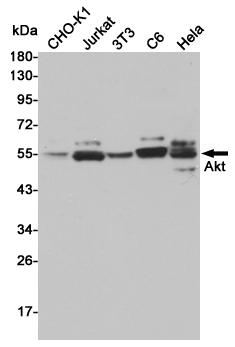
| WB | 咨询技术 | Human,Mouse,Rat |
| IF | 咨询技术 | Human,Mouse,Rat |
| IHC | 1/50-1/100 | Human,Mouse,Rat |
| ICC | 1/50-1/200 | Human,Mouse,Rat |
| FCM | 咨询技术 | Human,Mouse,Rat |
| Elisa | 1/10000 | Human,Mouse,Rat |
| Aliases | AKT1; PKB; RAC; RAC-alpha serine/threonine-protein kinase; Protein kinase B; PKB; Protein kinase B alpha; PKB alpha; Proto-oncogene c-Akt; RAC-PK-alpha |
| Entrez GeneID | 207 |
| WB Predicted band size | Calculated MW: 56 kDa; Observed MW: 60 kDa |
| Host/Isotype | Rabbit IgG |
| Antibody Type | Primary antibody |
| Storage | Store at 4°C short term. Aliquot and store at -20°C long term. Avoid freeze/thaw cycles. |
| Species Reactivity | Human,Mouse,Rat |
| Immunogen | The antiserum was produced against synthesized peptide derived from human AKT1/2/3. AA range:281-330 |
| Formulation | Purified antibody in PBS with 0.05% sodium azide,0.5%BSA and 50% glycerol. |
+ +
以下是3篇与AKT抗体相关的经典文献及其摘要内容的简要概括:
---
1. **文献名称**:*AKT/PKB Signaling: Navigating the Network*
**作者**:Manning, B.D. and Toker, A.
**摘要**:该综述系统总结了AKT信号通路的调控机制及生物学功能,强调使用特异性AKT抗体(如磷酸化抗体p-AKT Ser473/Thr308)在检测通路活性、亚细胞定位及翻译后修饰中的应用,并讨论了其在癌症研究中的价值。
---
2. **文献名称**:*Phosphorylation and Regulation of Akt/PKB by the Rictor-mTOR Complex*
**作者**:Sarbassov, D.D. et al.
**摘要**:本研究通过Western blot和免疫沉淀技术,利用AKT磷酸化特异性抗体(如p-AKT Ser473)首次揭示mTORC2复合物直接磷酸化AKT并调控其激活,为AKT在细胞存活和代谢中的功能提供关键实验证据。
---
3. **文献名称**:*The Akt Kinase: Molecular Determinants of Oncogenicity*
**作者**:Cheng, J.Q. et al.
**摘要**:文章通过免疫组化、Western blot等实验(使用AKT1/AKT2亚型特异性抗体),解析AKT异构体在肿瘤中的差异表达及激活机制,证实AKT过度活化与癌症进展相关,并探讨其作为治疗靶点的潜力。
---
**备注**:以上文献均涉及AKT抗体的实验应用(如检测表达、磷酸化状态或亚型区分),建议通过PubMed或Google Scholar检索完整原文以获取详细信息。
AKT antibodies are essential tools in biomedical research for studying the AKT protein kinase family (also known as protein kinase B, PKB), which plays a central role in regulating cell survival, growth, proliferation, and metabolism. The AKT pathway (PI3K/AKT/mTOR) is a critical signaling cascade activated by extracellular stimuli, such as growth factors or insulin, and is frequently dysregulated in cancers, diabetes, and neurodegenerative diseases. Three isoforms—AKT1. AKT2. and AKT3—share structural homology but exhibit distinct tissue-specific functions and disease associations. For example, AKT1 is linked to tumor progression, AKT2 to insulin signaling, and AKT3 to brain development.
AKT antibodies enable the detection, quantification, and localization of these isoforms and their activated phosphorylated forms (e.g., p-AKT Ser473 or Thr308) in techniques like Western blotting, immunohistochemistry (IHC), and immunofluorescence (IF). Specificity is crucial, as cross-reactivity between isoforms can lead to misinterpretation. Monoclonal antibodies offer high specificity for targeted epitopes, while polyclonal antibodies may detect broader conformational states. These reagents are vital for investigating AKT’s role in disease mechanisms, drug response (e.g., AKT inhibitors in oncology), and pathway crosstalk. However, variability in antibody performance across experimental conditions necessitates rigorous validation using controls like knockout cell lines or peptide blocking to ensure reliability. Overall, AKT antibodies remain indispensable for unraveling the complexities of cellular signaling and therapeutic targeting.
×